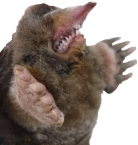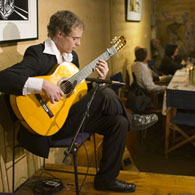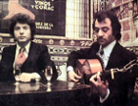Welcome to one of the most active flamenco sites on the Internet. Guests can read most posts but if you want to participate click here to register.
This site is dedicated to the memory of Paco de Lucía, Ron Mitchell, Guy Williams, Linda Elvira, Philip John Lee, Craig Eros, Ben Woods, David Serva and Tom Blackshear who went ahead of us.
We receive 12,200 visitors a month from 200 countries and 1.7 million page impressions a year. To advertise on this site please contact us.
|

|
|
non-standard keys in standard tuning
|
You are logged in as Guest
|
|
Users viewing this topic: none
|
|
Login  | |
|

   
mark indigo
Posts: 3625
Joined: Dec. 5 2007

|
 non-standard keys in standard tuning non-standard keys in standard tuning
|
|
|
I posted about this a little while ago, when lots of y'all were on holiday or getting banned or cowering in the corner hoping the flamenco police weren't coming for you next.... or whatever....
Anyway, i got a few responses, and a few people thought it was interesting so i should post it again (thanks guys)
What i'm interested in at the mo is playing things in unusual/non-standard/non-"traditional" keys but in standard tuning.
Just in case of misunderstanding, by standard tuning I mean E, A, D, G, B, E.
I know that, for example, rondeña with it's altered tuning is a kind of "standard" toque in flamenco, but just for the sake of argument that's what i'm meaning by standard tuning
by non-standard keys i mean playing things like bulerías or tangos etc. in any key other than the standard/traditional A phrygian por medio or soleá in E phrygian por arriba.
So that means in B phrygian (toño de Granaína), F# phrygian (toño de Tarantas), C# phrygian (i have seen this referred to as "toño de rondeña sin scordatura", but that's a bit of a mouthful....), G# phrygian (toño de minera) and D# phrygian (sometimes called E flat phrygian)
I'm also not saying anything against altered tunings, it's just that right now my focus is on standard tuning
i posted a couple of times in this thread, so here's the gist of it:
does anyone know who was first to play and/or record, for example, bulerias in F# phrygian or tangos in B phrygian?
and what about bulerias and tangos etc using C#phrygian , G# phrygian or D#?
I know Tomatito recorded Alejandria (rumba) in D# phrygian (1987), Enrique De Melchor recorded Marismas (fandango) in C#phrygian (1989) and Riqueni recorded Soniquete (buleria) in G# phrygian (1986) but don't know if they were the first, or if these were the first recordings, does anyone know?
I also find it hard to tell when unusual keys are being used, and if so which one, so any tips on telling would help (for a long time, before i realised different keys were being used, and sometimes different tunings, i drove myself crazy wondering how those different sounds were produced!)
i know there are some knowledgeable, experienced and high level players on here - maybe one of you could share your opinion on the easiest first foray into D#/Eflat phrygian bulerias/tangos?
meantime maybe i'll just start a list of recordings in non-standard keys in standard tuning and if anyone wants to they can add to it
Moraíto - Mercado Persa - Vals Bulería in F# phrygian on Morao Y Oro (and on Encuentro vid)
Moraíto - Pámpano Verde - Bulería in B phrygian and C# phrygian on Morao Morao (and on Encuentro vid)
Enrique De Melchor - La Dehesa - Bulerías de tarantos (F# phrygian)on Cuchichi
Enrique De Melchor - Callejon Del Aire - Bulerías in D# phrygian on La Noche Y El Dia (part of this is on the Encuentro vid - anyone got a tab for the rest?)
Gerardo Nuñez - Mi Patio - Tangos in D# phrygian on El Gallo Azul
Gerardo Nuñez -Puente De Los Alunados - Tanguillo in B phrygian on El Gallo Azul (and on Encuentro vid), also recorded on Calima with different title
Gerardo Nuñez - Jucal - Bulería in D# phrygian on Jucal
Gerardo Nuñez - Piedras Negras - Taranta/Solea por bulerias (F# phrygian)(anyone got a tab for this?!)
Vicente Amigo - Reino De Silia - Solea por Bulerías in D# phrygian on De Mi Corazon Al Aire
Vicente Amigo - Morao - Bulerías in D# phrygian on De Mi Corazon Al Aire
Vicente Amigo - El Mandaito - Bulería in C# phrygian on Vivencias Imaginadas
I think the Vicente Amigo Solea "Cordoba" on Ciudad De Las Ideas is also in D#/E flat phrygian, can anyone confirm?
On the Encuentro DVD Pepe Habichuela plays Tangos in C#, I think this is recorded on Habichuela En Rama, but not sure about the one on A Mandeli - anyone know?
i think the Tangos "Abadia" on Bordon De Trapo by Miguel Angel Cortes is in G# phrygian but not sure - can anyone confirm?
anyone know if Paco has recorded in any of these keys?
_
i got a couple of good replies to this, notably from pimiento and ricardo, which i kept copies of for my own interest, is it ok to paste these in here? if ok will save you guys writing all that again!
|
|
|
|
REPORT THIS POST AS INAPPROPRIATE |
Date Aug. 31 2008 8:22:17
 |
|

   
Ricardo
Posts: 14806
Joined: Dec. 14 2004
From: Washington DC

|
 RE: non-standard keys in standard tuning (in reply to mark indigo) RE: non-standard keys in standard tuning (in reply to mark indigo)
|
|
|
I think I said this in the orginal posting, but you underestimate the significance of the key of D. A lot of the keys you mention, the tonic chord is played as a bar so you have the "por medio" aire. I think Paco was one of the first to use the key of D in different ways, so you have the por medio sound barred up at 5th. From there the concept to move the barre to other postions was only logical. So I would say the experimenting in this regard was happening in the late 70's. About the other forms, I remember seeing P. Habichuela doing bulerias in Minera key, and Tomatito doing Bulerias in Taranta key, in the late l70's too. I heard about Viejin doing some crazy keys and tunings before the guys on your list recorded in the late 80's. Unfortunately, it is almost impossible to answer you questions specifically, since in might have been an obscure player that invented certain "grips"... one that accompanies only and does not record guitar solos or even for cante. So you would have to pick the brain of a working pro player who was in Spain during the late 70's early 80's to get some concrete answers.
In any case it is important to note that even "old school' players, or orthodox players such as the Habichuelas or Morao, picked up on the concept and embraced it for it's beauty and logic, and did not stubbornly adhere to the traditional keys and grips, just because of their roots or heritage. In flamenco, ideas get passed on like words and phrases, and get changed along the way too. Morao's use of the key of "C#" is very personal and still very "jerez" even if PDL did it first. 
Ricardo
_____________________________
CD's and transcriptions available here:
www.ricardomarlow.com
|
|
|
|
REPORT THIS POST AS INAPPROPRIATE |
Date Aug. 31 2008 21:15:12
 |
|

   
mark indigo
Posts: 3625
Joined: Dec. 5 2007

|
 RE: non-standard keys in standard tuning (in reply to Ricardo) RE: non-standard keys in standard tuning (in reply to Ricardo)
|
|
|
quote:
you underestimate the significance of the key of D. I think Paco was one of the first to use the key of D in different ways
that sounds interesting.... can you say more? isn't Solo Quiero Caminar in D phrygian? but with drop D tuning? i don't know much about D, does the tangos on Saura's Flamenco also use D? standard or drop D?
i think the tanguillo on Siroco is based around D but not sure again of tuning....
i would like to explore D a bit, maybe some alegrias/major key stuff as well as phrygian, but i'm a lazy git and can't be arsed to retune the guitar! also i'm not really doing any solo gigs or anything at the mo, only playing for dancers in classes and low level performances, so it's not really appropriate to have to retune the guitar....
i play in with other guitarists who are usually playing in E or A (phrygian) so i capo up or down and play in some of these other keys (usually they are capo-ed at 2, so if they are in A, i play open in B; and if they are in E i play either open in F# or capo 3 in D#).... until my brain explodes! i'm just starting to figure out/explore this stuff so it's real brain ache at the mo.... the 3rd encuentro Tomatito falseta transposes nicely into B tho....
quote:
A lot of the keys you mention, the tonic chord is played as a bar so you have the "por medio" aire
do you mean B, C#, D#, barred at 2, 4 or 6 respectively?
'cos you can also use B7 shape in 1st pos as tonic for B (and you can get a flat 9 at 1st fret, 2nd string, or hammer it on with 4th finger for a trad-style buleria intro at 3rd fret, 5th string); C shape barred/half-barred at 1st pos for C# (with or without flat 9 open 4th/D string); and D shape half-barred at 1st pos for D# (with flat 9 open 1st string)....
....and F# and G# relate more to por arriba than por medio, no?
not sure if i fully understood the point..... sorry!
rest of your post also really interesting, thanks ricardo, i guess i was hoping there might be someone around on here who either is or knows someone who is a quote:
working pro player who was in Spain during the late 70's early 80's !!!
anyway, it's not really that important, i was just curious.... if truth be told i guess i'm more interested in finding out what stuff is played in what key, and in getting to grips with trying to play the stuff than who was actually first to do it.
and BTW, there was also a post by someone who said the first to use D# was someone called "David Serva", who i'd never heard of. I asked for the full story, but never heard back....
|
|
|
|
REPORT THIS POST AS INAPPROPRIATE |
Date Sep. 1 2008 1:12:47
 |
|

   
NormanKliman
Posts: 1143
Joined: Sep. 1 2007

|
 RE: non-standard keys in standard tuning (in reply to mark indigo) RE: non-standard keys in standard tuning (in reply to mark indigo)
|
|
|
Hi Mark,
David Serva says that he showed everybody in Madrid the idea of playing in D sharp, and that he got the idea from the dancer and guitarist Mario Maya.
A friend of mine used to accompany tangos in B-C (granaína) a lot, and I was very surprised when I first noticed that. I think he might have gotten the idea from a recording of Camarón and Paco.
In recordings from the early 20th century, we can hear that "slow fandango" kinds of cantes (malagueñas, granaínas, tarantas, cartageneras, etc.) were accompanied in different keys, probably as a result of guitarists looking for more working space on the fretboard or maybe just trying to do things differently. The most commonly used "alternative" key for these cantes was B-C (granaína). There's a malagueña in B-C that swings into a verdial at the end, which is very unusual.
_____________________________
Be here now.
|
|
|
|
REPORT THIS POST AS INAPPROPRIATE |
Date Sep. 4 2008 1:54:42
 |
|

   
mark indigo
Posts: 3625
Joined: Dec. 5 2007

|
 RE: non-standard keys in standard tuning (in reply to NormanKliman) RE: non-standard keys in standard tuning (in reply to NormanKliman)
|
|
|
Hi Norman, thanks for posting that again, and with more info, really interesting.
quote:
David Serva says that he showed everybody in Madrid the idea of playing in D sharp, and that he got the idea from the dancer and guitarist Mario Maya
Just out of interest, any idea when this was? early/late seventies? early eighties?
quote:
A friend of mine used to accompany tangos in B-C (granaína) a lot, .... I think he might have gotten the idea from a recording of Camarón and Paco
I thought paco was doing something really clever in A phrygian for a long time, 'til i saw a tab and it was, as you say, B-C. The track was "Detras Del Tuyo Se Va" from the 1969 "Con La Colaboracion Especial" album but on the tab it was called "La Espera"
quote:
.....recordings from the early 20th century ..... malagueña in B-C that swings into a verdial
That sounds interesting, especially as playing in different keys is usually considered a modern thing. Do you have any references to the recordings? I've been thinking for a while about going back and listening to some old recordings again.
|
|
|
|
REPORT THIS POST AS INAPPROPRIATE |
Date Sep. 5 2008 1:52:35
 |
|

   
NormanKliman
Posts: 1143
Joined: Sep. 1 2007

|
 RE: non-standard keys in standard tuning (in reply to mark indigo) RE: non-standard keys in standard tuning (in reply to mark indigo)
|
|
|
Hi Mark,
quote:
early/late seventies? early eighties?
Probably late 70s-early 80s. I'll ask him again.
quote:
Do you have any references to the recordings?
Almost everything recorded in those styles by Chacón and similar voices. I say "those styles" because most other cantes were acccompanied using por medio/arriba and other similarly unsurprising alternatives, but malagueñas, granaínas, tarantas, mineras, cartageneras, etc. were often accompanied in one of several different toques: por arriba, por granaína, por Levante and sometimes even por medio. So, although malagueñas were usually accompanied por arriba, you wouldn't have to look very hard to find examples in B-C or F#-G. Same thing for the other styles.
One of the things that could be studied, then, is how different guitarists used a given chord with different harmonic implications. For example, a G chord is used differently in E-F playing than it is in B-C playing, do you know what I mean? That would make for an interesting analysis of the basic music theory involved in playing flamenco guitar. I get the impression, though, that you're more interested in unusual combinations like a guajira in C major or a siguiriya in F# Phrygian, for example, and I think you'll find many more examples of those combinations in more modern recordings.
_____________________________
Be here now.
|
|
|
|
REPORT THIS POST AS INAPPROPRIATE |
Date Sep. 6 2008 2:43:21
 |
|

   
mark indigo
Posts: 3625
Joined: Dec. 5 2007

|
 RE: non-standard keys in standard tuning (in reply to NormanKliman) RE: non-standard keys in standard tuning (in reply to NormanKliman)
|
|
|
quote:
For example, a G chord is used differently in E-F playing than it is in B-C playing, do you know what I mean? That would make for an interesting analysis of the basic music theory involved in playing flamenco guitar.
If you mean that it has a different relationship to the other chords in the key, and a different function within that key, then yeah I do know what you mean.
ie in por arriba/E phrygian G is the 5th/dominant of the relative major (C), whereas in por granaina/B phrygian G IS the relative major.
Just for the sake of the theory I think of the relative major as 1 and everything relates to that, so in por arriba/E phrygian, C is 1, D is 2, E is 3 etc., in por granaina/B phrygian, G is 1, A is 2, B is 3 etc.
In Solea por arriba, I still think of E as "home" or tonic, even though I assign it the number "3" (F is 4, G is 5 etc.). That way in cantinas in C, E is still 3. I don't know if that makes sense, but I got it from Jingle, and it works for me.
Part of my interest in exploring these other keys is theoretical, because of the mode scale patterns. There being seven modes, and seven patterns based on them covering the fingerboard, when each pattern is played in first/open position, you get one of seven keys. If I play a bit of solea (E phrygian), bulerias (A phrygian), granainas (B phrygian), tarantas (F# phrygian), and alegrias in E and A major, I have got six of them, so I need something in D# to make it all kind of neat and tidy! (yeah, I know, it's kinda geeky)
quote:
I get the impression, though, that you're more interested in unusual combinations like a guajira in C major or a siguiriya in F# Phrygian
Well, I'm that's sure interesting, but in a way i'm actually less interested in one offs than in general trends. And I'm also interested in the way that a one off (such as, say, if Mario Maya starts to play in D#) gets passed around (such as, as you say, by David Serva) and ends up being a common phenomena ('cos they're neat stories!). I'm not likely to get asked to play something that is a one off, but it might be expected of me to play something that has become quite common.
As I play for dancers I tend to be much more au fait with a compas stuff than actual tarantas and granainas etc., so it's sort of more natural for me to play bulerias, tangos etc. with F# and B (as well as E and A, not instead of!).
The interest in "who did it first, when?" is partly just general interest/curiosity, but also as when I started with flamenco I listened to and learned a lot of older styles, as a kind of base to build on, so it makes sense to me to start at the beginning as it were with new keys. So far the "easiest" thing in D# I've found is from the Encuentro Enrique De Melchor, which is a couple of falsetas from the track "Callejon Del Aire" on La Noche Y El Dia (on the cd it is not easy to hear the guitar as there is a whole group with flute etc on there).
|
|
|
|
REPORT THIS POST AS INAPPROPRIATE |
Date Sep. 7 2008 12:54:33
 |
|

   
Ricardo
Posts: 14806
Joined: Dec. 14 2004
From: Washington DC

|
 RE: non-standard keys in standard tuning (in reply to mark indigo) RE: non-standard keys in standard tuning (in reply to mark indigo)
|
|
|
quote:
not sure if i fully understood the point..... sorry!
I meant that the concept of the moveable barre chord with root on the 5th string, can give the "aire" of por medio in any key you want, and the other chord voicings you mention fill out the unique timbre of whichever key you are in provides. So I guess the point is that it is not such a stretch to understand how the concept of using the key of C# or D# evolved, once you see the logic of using the 5th fret barre of D (rather than the open position or any of the other nice "D" chords) as HOME, regardless if the 6th is tuned different. I am thinking that door was opened by Paco, but even Nino Ricardo had some stuff like that for Solea up in 7th/8th position. But it gets more significant when you see it used for strumming/accompanying cante.
Likewise, whenever you have a barre chord on the 6th string root, then you are imitating the "por Arriba" sound, but the point of Taranta and Minera, or even Granaina, is to have the open string dissonances give the "aire". For example, you can give a bit of Taranta aire, even to something "por medio" by playing a chord like this:
E--5--
B--5--
G--7--
D--8--
A--7--
E--5--
Or arriba aire:
E--5--
B--5--
G--6--
D--8--
A--7--
E--5--
Or vice versa, por medio aire to Solea:
E--7--
B--9--
G-10--
D--9---
A--7--
E--0--
Hope you see the logic there.
Ricardo
_____________________________
CD's and transcriptions available here:
www.ricardomarlow.com
|
|
|
|
REPORT THIS POST AS INAPPROPRIATE |
Date Sep. 7 2008 14:08:27
 |
|

   
Kevin
Posts: 294
Joined: Sep. 7 2008

|
 RE: non-standard keys in standard tuning (in reply to mark indigo) RE: non-standard keys in standard tuning (in reply to mark indigo)
|
|
|
I mentioned this before in another thread but here it is again. I am working on the course work that will lead to my dissertation and I hope to take a theoretical approach. My book is on the back burner until I finish school which is OK because I am discovering new information that might be pertinent to my thesis.
Anyway, here it is again.
Major Keys--------------------Relative Minor Keys---------------Relative Phrygian 'Keys'
C------------------------------------Am----------------------------------------E
Caracoles, Alegrias-----------Farruca------------------------------Solea,Bules etc.
G-------------------------------------Em----------------------------------------B
Not so common-----------Farruca, Rosas,------------------Granaina (often ends on Em)
----------------------------------Alegrias de Cordoba--------------------Bules
D-------------------------------------Bm---------------------------------------F#
Alegrias---------------------------------------------------------------------Taranta
A--------------------------------------F#---------------------------------------C#
Alegrias----------------------------------------------------------------------Bulerias
Minera, Rondena
E--------------------------------------C#---------------------------------------G#
Alegrias, Romera, por Rosas -------------------------------------------Bulerias
B--------------------------------------G#--------------------------------------D#
-------------------------------------------------------------------------------Bulerias
F---------------------------------------Dm---------------------------------------A
---------------------------------------------------------------------------------Bulerias
Bb--------------------------------------G----------------------------------------D
--------------------------------------------------------------------------------Bulerias
The Phrygian tonality of Flamenco is closely related to the minor system of tonality, though in Phrygian, modality may become prevalent at specific points in time due to a variety of factors.
Depending on the use of a full bar or lack thereof, I still have a somewhat difficult time distinguishing C# and D#. If it is barred completely I have a hard time. But if the high E rings I can tell right away.
This list is nowhere near conclusive. An investigation into the origins of different keys in standard tunings would be interesting. I know of several guitarists who claim the discovery of D-Eb.
|
|
|
|
REPORT THIS POST AS INAPPROPRIATE |
Date Sep. 7 2008 15:55:06
 |
|

   
Ricardo
Posts: 14806
Joined: Dec. 14 2004
From: Washington DC

|
 RE: non-standard keys in standard tuning (in reply to Kevin) RE: non-standard keys in standard tuning (in reply to Kevin)
|
|
|
quote:
ORIGINAL: Kevin
Maybe this should bea different thread but I was talking to my teacher who said that there are certain progressions that occur in the toques libres that sistinguish one from another and that over time that has been somewhat lost. FOOD FOR THOUGHT?
I don't think it has been "lost" but rather, when palos are "mixed" it should be made known, and it often is not. For example, Paco's "Antonia" is bulerias por solea, but he should have described it "in the tonos of Taranta". I don't see any problems with mixing up tonalities and palos, with or without cante. Minera is associated with the key of G#, so in C# it is just like dropped down a set of strings like the difference between A and D. But I think a minera in C# should be called that, simply to clearify.
Vicente Amigo as done so many palos in the key of D# that his music might be hard for some aficionados to distinguish. All his palos in D# might have a similar "aire" and flavor, which one could read as "it all sounds the same nowadays". I think he is a unique case though. Just because you might have some new music in a fancy or non typical tonality, does not mean you can't still find a way to keep the "aire" and flavor of the original. For example, Nuñez does a good job of giving the "por medio" aire, and jerez flavor, to his bulerias in D#.
Ricardo
_____________________________
CD's and transcriptions available here:
www.ricardomarlow.com
|
|
|
|
REPORT THIS POST AS INAPPROPRIATE |
Date Sep. 15 2008 12:33:31
 |
|

   
Ricardo
Posts: 14806
Joined: Dec. 14 2004
From: Washington DC

|
 RE: non-standard keys in standard tuning (in reply to mecmachin) RE: non-standard keys in standard tuning (in reply to mecmachin)
|
|
|
quote:
ORIGINAL: mecmachin
hi Ricardo,
yes I meant "re" and not "re sostenido". I have never worked out a piece in D phrygian, so I didn't know it is possible, at least not in natural tuning.
My undestanding until now was this: the phrygian modes from A to Eb include the tone of 1st and 6th in the diatonic scale which they are derived from. These strings sounding openly are most responsible for the caracteristic sound of the key.
Tuning the 6th down in D phrygian clearly helps, this is the rondena tuning, right? But I have never tried that either. Stupborn.
In D phrygian tangos of gerardo and Paco and others, there are times you will hear the open E string ring, even it is out of key!!!  But you are right, most of the keys benefit from the open strings when possible. Key of C# is VERY popular now, and the open E's are available depending on the harmony at the time. Rondeña tuning has drop D but also the G string is dropped to F#. The key is usually C# phrygian, though there are some exceptions using this same tuning. But you are right, most of the keys benefit from the open strings when possible. Key of C# is VERY popular now, and the open E's are available depending on the harmony at the time. Rondeña tuning has drop D but also the G string is dropped to F#. The key is usually C# phrygian, though there are some exceptions using this same tuning.
quote:
Bulerias in G phrygian - Cañizares from his latest album. (3 flats - I'd imagine that would be hard to pull off in standard tuning)
Nuñez buleria in drop C tuning modulates from C minor to Eminor/B prhygian. During the C minor part there is a section that makes use of G phrygian. He even lets that E natural ring at times, first string open. Nunez granaina also has a section in G phrygian (modulates B phrygian->D#->G-> back to B). Calima has open tuning and uses C phrygian.
Vicente has Solea por buleria, Solea (as you noted), 2 bulerias, part of granaina, Tanguillo, a rumba or two, and maybe something else I forgot now, all in D# phrygian, spread over only 4 albums.
I would say except for the odd brief modulation, the 3 unexplored keys in standard tuning are C phrygian, Bb phrygian, and F phrygian. Each of these contains useful open strings even! (E and G for C phrygian, Cb or B for Bb phrygian, A for F phrygian).
_____________________________
CD's and transcriptions available here:
www.ricardomarlow.com
|
|
|
|
REPORT THIS POST AS INAPPROPRIATE |
Date Jan. 11 2011 15:45:53
 |
|
 New Messages New Messages |
 No New Messages No New Messages |
 Hot Topic w/ New Messages Hot Topic w/ New Messages |
 Hot Topic w/o New Messages Hot Topic w/o New Messages |
 Locked w/ New Messages Locked w/ New Messages |
 Locked w/o New Messages Locked w/o New Messages |
|
 Post New Thread
Post New Thread
 Reply to Message
Reply to Message
 Post New Poll
Post New Poll
 Submit Vote
Submit Vote
 Delete My Own Post
Delete My Own Post
 Delete My Own Thread
Delete My Own Thread
 Rate Posts
Rate Posts
|
|
|
Forum Software powered by ASP Playground Advanced Edition 2.0.5
Copyright © 2000 - 2003 ASPPlayground.NET |
0.078125 secs.
|


 Printable Version
Printable Version













 New Messages
New Messages No New Messages
No New Messages Hot Topic w/ New Messages
Hot Topic w/ New Messages Hot Topic w/o New Messages
Hot Topic w/o New Messages Locked w/ New Messages
Locked w/ New Messages Locked w/o New Messages
Locked w/o New Messages Post New Thread
Post New Thread